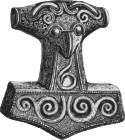- Njörun
-
In Norse mythology, Njörun is a goddess attested in the Prose Edda, written in the 13th century by Snorri Sturluson, and various kennings (including once in the Poetic Edda). Scholarly theories have proposed that Njörun may represent the earth. Possible etymological connections to the Norse god Njörðr and the Roman goddess Nerio have been proposed.
Contents
Attestations
Njörun is listed (after Bil) as an ásynja within the Prose Edda book Skáldskaparmál. No further information outside of her name is provided there.[1] In addition, the name occurs in kennings for women in poetry by Kormákr Ögmundarson, Hrafn Önundarson and Rögnvaldr Kali as well as in Krákumál and verses in Íslendinga saga, Njáls saga and Harðar saga.[2] Eld-Njörun (meaning "fire-Njörun") occurs in women kennings in poetry by Gísli Súrsson and Björn Breiðvíkingakappi[3] while hól-Njörun occurs in a somewhat dubious kenning in a stanza by Björn hítdælakappi.[4] Draum-Njörun (meaning "dream-Njörun") is cited in the Poetic Edda poem Alvíssmál as a word from the language of the dwarves for the night. The same word occurs in Nafnaþulur.[5]
Theories
The name Njörun may be etymologically related to the names of the Norse god Njörðr and the Roman goddess Nerio.[6] Andy Orchard says that Njörun is a "mysterious (and possibly fictitious) figure" of whom nothing else is known.[7] Finnur Jónsson suggested that Njörun may be a name for the earth.[2]
Albert Murey Sturtevant notes that next to the goddess name Gefjon, "the only other feminine personal name which contains the suffix -un is Njǫr-un, recorded only in the þulur [...], and among the kvenna heiti ókend. Whatever the stem syllable Njǫr- represents (perhaps *ner- as in *Ner-þuz>Njǫrðr), the addition of the n- and un-suffixes seems to furnish an exact parallel to Gef-n : Gefj-un (cf. Njǫr-n : Njǫr-un)."[8]
Notes
- ^ Faulkes (1995:157).
- ^ a b Finnur Jónsson (1931:429).
- ^ Finnur Jónsson (1931:106).
- ^ Finnur Jónsson (1931:276).
- ^ Finnur Jónsson (1931:84).
- ^ Finnur Jónsson (1913:110) suggests a Njörðr connection, Ásgeir Blöndal Magnússon (1989:671) additionally suggests a connection between Njörun and Nerio.
- ^ Orchard (1997:119).
- ^ Sturtevant (1952:167).
References
- Ásgeir Blöndal Magnússon (1989). Íslensk orðsifjabók. Orðabók Háskólans.
- Faulkes, Anthony (Trans.) (1995). Edda. Everyman. ISBN 0-460-87616-3
- Finnur Jónsson (1913). Goðafræði Norðmanna og Íslendinga eftir heimildum. Hið íslenska bókmentafjelag.
- Finnur Jónsson (1931). Lexicon poeticum. S. L. Møllers bogtrykkeri.
- Orchard, Andy (1997). Dictionary of Norse Myth and Legend. Cassell. ISBN 0-304-34520-2
- Sturtevant, Albert Morey (1952). "Regarding the Old Norse name Gefjon" as published in Scandinavian Studies; volume 24 (number 4, November). ISSN 0036-5637
Norse paganism Deities,
heroes,
and figuresOthersAsk and Embla · Dís (Norns · Valkyries) · Dwarf · Einherjar · Elves (Light elves · Dark elves) · Fenrir · Hel · Jörmungandr · Jötunn · Sigurd · Völundr · Vættir
Locations Asgard · Bifröst · Fólkvangr · Ginnungagap · Hel · Jötunheimr · Midgard · Múspellsheimr · Niflheim · Valhalla · Vígríðr · Wells (Mímisbrunnr · Hvergelmir · Urðarbrunnr) · YggdrasilEvents Sources Society See also Categories:
Wikimedia Foundation. 2010.
